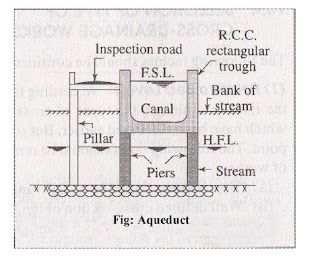What are cross drainage works?
In an irrigation project, when the network of main canals, branch canals, distributaries, etc. are provided, then these canals may have to cross the natural drainages like rivers, streams, nallahs, etc at different points within the command area of the project. The crossing of the canals with such obstacles cannot be avoided. So, suitable structures must be constructed at the crossing point for the easy flow of water of the canal and drainage in the respective directions. These structures are known as cross-drainage works.
The necessity of Cross-drainage works:
o The water-shed canals do not cross natural drainages. But in the actual orientation of the canal network, this ideal condition may not be available and obstacles like natural drainages may be present across the canal. So, cross drainage works must be provided for running the irrigation system.
o At the crossing point, the water of the canal and the drainage get intermixed. So, for the smooth running of the canal with its design discharge the cross drainage works are required.
o The site condition of the crossing point may be such that without any suitable structure, the water of the canal and drainage can not be diverted to their natural directions. So, the cross drainage works must be provided to maintain their natural direction of flow.
Types of Cross-Drainage Works:
(1) Type I (Irrigation canal passes over the drainage)
(a) Aqueduct
(b) Siphon aqueduct
(2) Type II (Drainage passes over the irrigation canal)
(a) Super passage
(b) Siphon super passage
(3) Type III (Drainage and canal intersection each other of the same level)
(a) Level Crossing
(b) Inlet and outlet
Selection of type of cross-drainage works
Relative bed levels
Availability of suitable foundation
Economical consideration
Discharge of the drainage
Construction problems
Aqueduct
The aqueduct is just like a bridge where a canal is taken over the deck supported by piers instead of a road or railway. Generally, the canal is in the shape of a rectangular trough which is constructed with reinforced cement concrete. Sometimes, the trough may be of a trapezoidal section.
o An inspection road is provided along the side of the trough.
o The bed and banks of the drainage below the trough are protected by boulder pitching with cement grouting.
o The section of the trough is designed according to the full supply discharge of the canal.
o A freeboard of about 0.50 m should be provided.
o The height and section of piers are designed according to the highest flood level and velocity of flow of the drainage.
o The piers may be of brick masonry, stone masonry, or reinforced cement concrete.
o Deep foundation (like a good foundation) is not necessary for the piers. The concrete foundation may be done by providing the depth of foundation according to the availability of hard soil.
 |
| aqueduct |
Siphon Aqueduct
 |
| siphon aqueduct |
Super Passage
 |
| super passage |
Siphon Super Passage
 |
| Level Crossing |
Level Crossing
 |
| Level Crossing |
Inlet and outlet
 |
| Inlet and outlet |
What is Canal Fall?The necessity of Canal Falls and Types of Canal Falls
What are cross drainage works? Types of Cross-Drainage Works
Spillway and Necessity of Spillways
Dams and Different parts & terminologies of Dams?
Divide wall and main function
The layout of a Diversion Head Works and its components






No comments:
Post a Comment
If you are getting more information from civilengineerfriend page please give your comments. Share the page information in your whatsapp group. Subscribe our page to get more information.